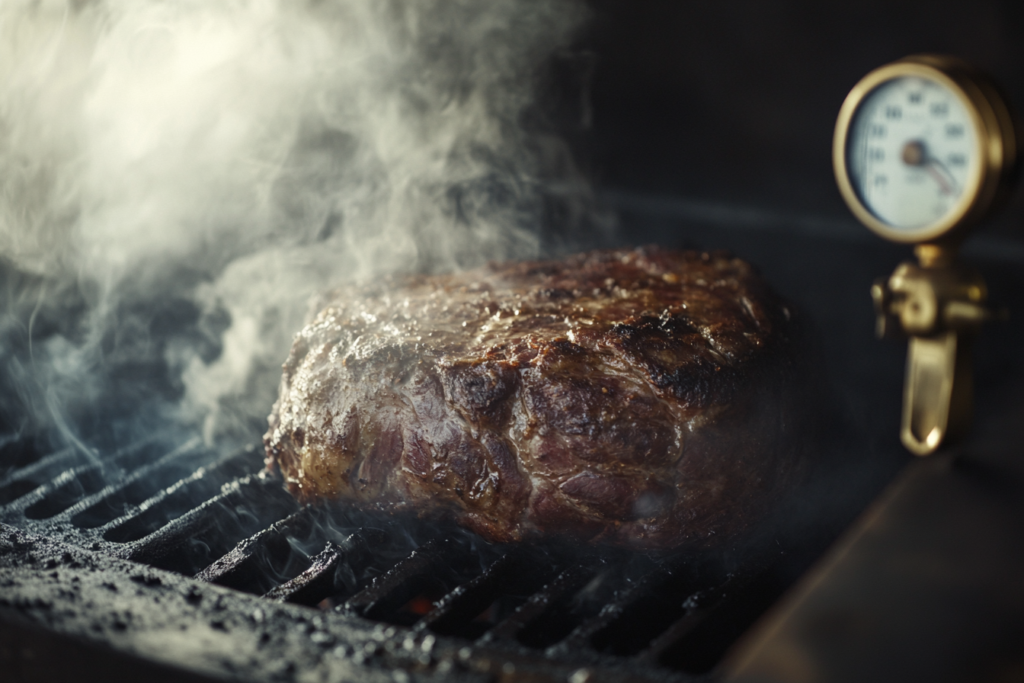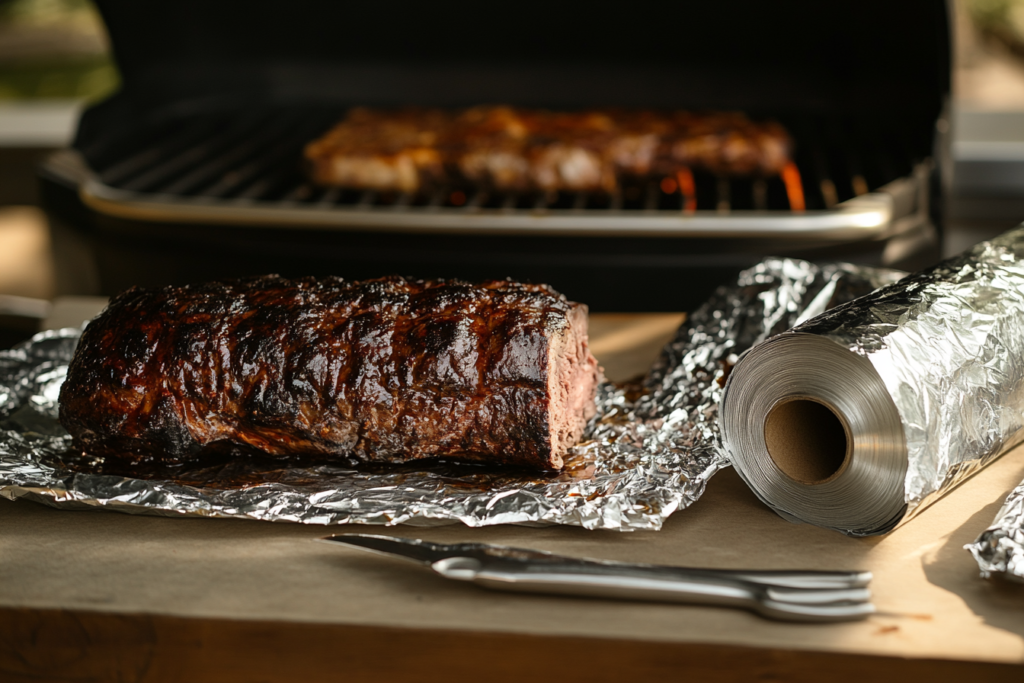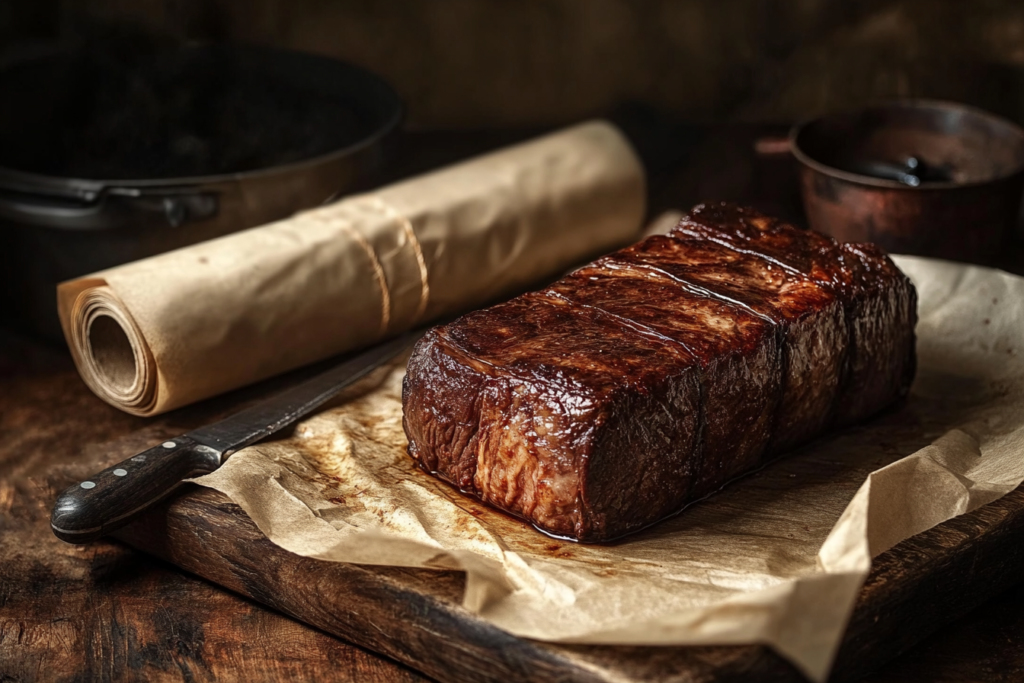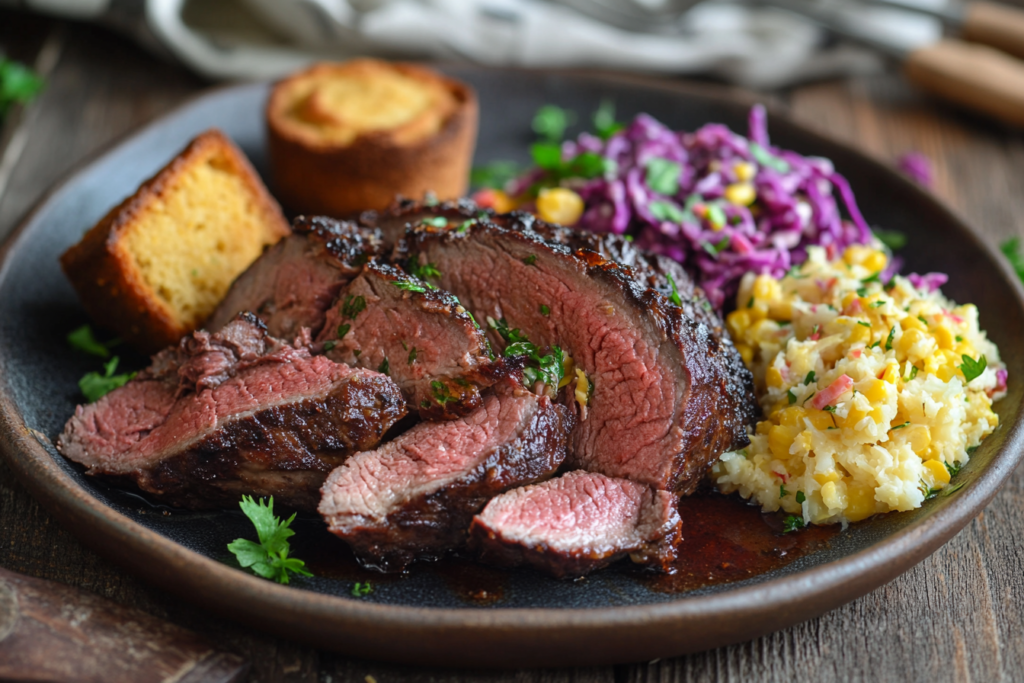Introduction
Smoking a chuck roast is a beloved technique among barbecue enthusiasts, celebrated for transforming a budget-friendly cut of beef into a tender, flavorful masterpiece. Knowing when to wrap a smoked chuck roast is a crucial step in this process, as it ensures the meat retains its moisture, achieves ideal tenderness, and develops the perfect smoky flavor.
Wrapping a chuck roast is an essential step for many, helping to preserve moisture, enhance tenderness, and navigate the infamous “stall” that can frustrate even experienced pitmasters. This article will guide you through understanding when and how to wrap a smoked chuck roast, ensuring your next barbecue session is a smoky success.
Understanding the Smoking Process

What Is a Smoked Chuck Roast?
A smoked chuck roast is a popular barbecue dish made by slow-cooking a beef chuck roast over wood smoke. This cut of meat, known for its rich marbling and connective tissue, benefits immensely from the “low-and-slow” method of cooking. Knowing when to wrap a smoked chuck roast is essential to ensure the connective tissues break down, yielding a tender, juicy texture and deep smoky flavor.
Unlike brisket, which is also a barbecue favorite, chuck roast is more affordable and cooks faster, making it an excellent choice for those looking to perfect their smoking skills without committing to a lengthy cook time.
The Role of Low-and-Slow Cooking
Smoking a chuck roast is all about patience. The low-and-slow method allows the meat to cook gradually, letting the smoke infuse its flavors while the fat renders and tenderizes the roast. Maintaining a consistent smoker temperature—usually around 225°F to 250°F—is critical to achieving the perfect balance of smoke flavor and tenderness.
However, this slow process often encounters a phenomenon called “the stall,” where the internal temperature of the roast plateaus. This is where wrapping comes into play, helping to overcome this hurdle and maintain the integrity of the cook.
Why Wrapping Is Essential
Wrapping a chuck roast serves multiple purposes:
- Moisture Retention: Wrapping helps prevent the roast from drying out by locking in its natural juices.
- Overcoming the Stall: During the stall, the evaporation of moisture from the meat’s surface can slow the cooking process. Wrapping creates a barrier, reducing evaporation and accelerating the cook.
- Flavor Preservation: Proper wrapping protects the bark (the crusty, flavorful exterior) while preserving the smoky essence of the roast.
When to Wrap a Chuck Roast
General Temperature Guidelines
The most common rule of thumb for when to wrap a smoked chuck roast is to do so when the internal temperature reaches 150°F to 165°F. At this point, the roast has absorbed enough smoky flavor, and wrapping helps it move through the stall phase while preserving its texture and moisture.
Investing in a reliable meat thermometer is essential for tracking the internal temperature accurately. Maintaining consistent smoker temperatures is equally important to avoid sudden spikes or drops that could impact the timing and effectiveness of the wrapping process.
Visual Cues to Look For
In addition to temperature, visual cues can indicate when it’s time to wrap your chuck roast:
- Bark Formation: Look for a firm, dark crust on the surface of the roast. This is a sign that the roast has developed enough flavor from the smoke.
- Juice Appearance: If you notice beads of moisture pooling on the surface, it’s an excellent time to wrap. This ensures the juices stay locked in.
The “Stall” Phase and Its Importance
The stall is a natural part of the smoking process. It occurs when the meat’s internal temperature plateaus, usually around 150°F to 170°F, as moisture evaporates and cools the surface of the roast. This can last anywhere from 1 to 2 hours, depending on the size of the chuck roast and the smoker’s humidity.
Wrapping the roast during the stall minimizes evaporation, allowing the internal temperature to rise steadily without sacrificing moisture.
Choosing the Right Wrapping Method (Foil vs. Butcher Paper)
Two common materials are used for wrapping smoked chuck roasts: aluminum foil and butcher paper.

- Foil: Known as the “Texas Crutch,” foil is excellent for trapping moisture and speeding up the cook. It creates a sealed environment, which prevents any evaporation and results in an ultra-tender roast. However, foil can soften the bark, so it’s best for those who prioritize tenderness over a crispy crust.
- Butcher Paper: Butcher paper is more breathable than foil, allowing some moisture to escape while protecting the roast from drying out. This method retains the bark’s texture and smoky flavor, making it a favorite among barbecue purists.
Each method has its pros and cons, so your choice will depend on your personal preferences and the results you aim to achieve.
How to Properly Wrap a Chuck Roast
Step-by-Step Process

Wrapping a smoked chuck roast might seem straightforward, but a few precise steps can make a big difference in the final results. Here’s a step-by-step guide:
- Prepare Your Wrapping Material:
Choose either aluminum foil or butcher paper. If using foil, ensure you have a large enough sheet to fully enclose the roast without any leaks. For butcher paper, use multiple layers if needed to prevent tearing. - Remove the Roast from the Smoker:
When the internal temperature of the roast reaches 150°F to 165°F or the bark has formed to your liking, carefully remove the roast from the smoker. - Place the Roast in the Center of the Wrap:
Lay your wrapping material on a flat surface and place the chuck roast in the center. If desired, you can add a splash of broth, melted butter, or beef tallow for extra moisture and flavor. - Wrap Tightly:
Fold the material over the roast tightly to create a snug package. For foil, ensure all edges are sealed to lock in juices. If using butcher paper, fold and roll the edges securely to minimize air pockets. - Return to the Smoker:
Place the wrapped roast back in the smoker with the seam side facing down. This helps keep the wrap secure and prevents any leaks. - Monitor the Temperature:
Continue cooking the roast until it reaches an internal temperature of 200°F to 205°F, which is the ideal range for a tender, pull-apart texture. Use a probe thermometer to check for doneness.
Ensuring a Tight and Effective Wrap
A loose wrap can allow juices to escape, drying out the roast. To ensure an effective wrap:
- Make sure there are no gaps or tears in the wrapping material.
- Avoid excessive liquid additions that might cause the wrap to break down.
- Handle the wrapped roast carefully to prevent punctures or leaks.
Common Mistakes to Avoid
Here are some pitfalls to watch out for:
- Wrapping Too Early: Wrapping before the bark has formed can result in a mushy exterior.
- Using the Wrong Material: While foil is effective, it can trap too much steam, softening the bark. Butcher paper is better for maintaining texture but may not be as forgiving for beginners.
- Skipping the Resting Period: A properly wrapped roast still needs resting time for the juices to redistribute (more on this later).
Benefits of Wrapping a Chuck Roast
Retaining Moisture
One of the primary benefits of wrapping is moisture retention. The wrapping material acts as a barrier, trapping the roast’s natural juices and preventing them from evaporating. This is especially important during the later stages of cooking, where prolonged exposure to heat can dry out the meat.
Accelerating the Cooking Process
Wrapping speeds up the cooking process by insulating the roast and reducing evaporation. This is particularly useful during the stall phase, where the internal temperature struggles to rise. By wrapping, you can cut down on cooking time without sacrificing quality.
Preserving Flavor and Bark Texture
The wrapping process protects the roast’s smoky flavor while preventing the bark from becoming overly dry. Butcher paper, in particular, is effective at striking a balance between moisture retention and bark preservation, making it an ideal choice for many barbecue enthusiasts.
After Wrapping: Resting and Serving
How Long to Rest After Wrapping
Once the chuck roast reaches its target internal temperature of 200°F to 205°F, remove it from the smoker and let it rest. Resting is crucial as it allows the juices to redistribute throughout the meat, enhancing its tenderness and flavor.
- Ideal Resting Time: Let the wrapped roast rest for at least 30 minutes to 1 hour. For best results, place the roast in a cooler or insulated container to maintain warmth during the resting period.

Tips for Slicing and Serving
When it’s time to serve, slice the chuck roast against the grain. Cutting against the grain shortens the meat fibers, making each bite more tender. If you plan to shred the roast for sandwiches or tacos, the wrapping process will have ensured the perfect texture for easy pulling.
Maintaining Tenderness and Flavor
To keep the roast tender and flavorful:
- Use a sharp knife for clean cuts.
- Serve with the juices retained in the wrapping material for added moisture.
- Pair with complementary sides like smoked vegetables, coleslaw, or barbecue sauce.
Mastering when to wrap a smoked chuck roast is a game-changer for any barbecue enthusiast, ensuring your roast stays tender and flavorful. If you’re new to smoking or want to refine your technique, check out Smoked Chuck Roast Easy Guide for step-by-step instructions to achieve perfection. For those smoking at specific temperatures, the article Smoking Chuck Roast at 225°F provides detailed guidance on maintaining consistent heat and smoke infusion. These resources will not only help you nail the timing but also enhance your overall smoking skills, transforming a budget cut into a tender masterpiece.
FAQs
When Should You Wrap a Chuck Roast When Smoking?
You should wrap a chuck roast when smoking once it reaches an internal temperature of 150°F to 165°F. At this stage, the roast has absorbed sufficient smoke flavor, and wrapping helps push it through the “stall,” where the internal temperature plateaus. Wrapping locks in moisture, accelerates cooking, and ensures a tender result without drying out the meat.
At What Temperature Does Chuck Roast Fall Apart?
Chuck roast becomes fall-apart tender when its internal temperature reaches 200°F to 205°F. At this point, the connective tissues and collagen have broken down, creating a juicy, pull-apart texture. Use a meat probe to ensure it’s tender, as proper cooking temperature is key to achieving the desired consistency.
How to Get a Good Bark on Smoked Chuck Roast?
To develop a good bark on smoked chuck roast, start by applying a generous layer of dry rub containing salt, sugar, and spices. Smoke the roast at 225°F to 250°F without wrapping too early, as bark forms from the Maillard reaction and smoke exposure. Use butcher paper instead of foil during wrapping to retain the bark’s texture while preserving moisture.
Should I Wrap My Chuck Roast in Foil or Butcher Paper?
Both foil and butcher paper work well, but the choice depends on your preference. Foil creates a tight seal, speeding up the cook and producing an ultra-tender texture, though it softens the bark. Butcher paper is more breathable, allowing moisture to escape while maintaining a flavorful, crispy bark, making it ideal for smoky, textured results.
Conclusion
Wrapping a smoked chuck roast is a game-changing technique that can elevate your barbecue skills. By understanding the timing, materials, and methods, you can master the art of wrapping to ensure a tender, juicy, and flavorful roast every time. Whether you prefer foil for maximum tenderness or butcher paper for a balanced texture, wrapping is a versatile tool for overcoming challenges like the stall and preserving the roast’s natural flavors.
With these tips, your next smoked chuck roast is sure to impress your family and friends. Enjoy your smoky success!

